Ulmus chumlia is a small deciduous tree endemic to the Himalaya from the Kashmir to central Nepal, and the provinces of Yunnan, Sichuan and Xizang (Tibet) in China. It is found in broadleaf forest on mountain slopes at elevations of 1000–3000 m. Richens noted that the species appeared to be the same as that named by Grudzinskaya as Ulmus androssowii var. virgata, which she considered an intermediate between U. minor and U. pumila.
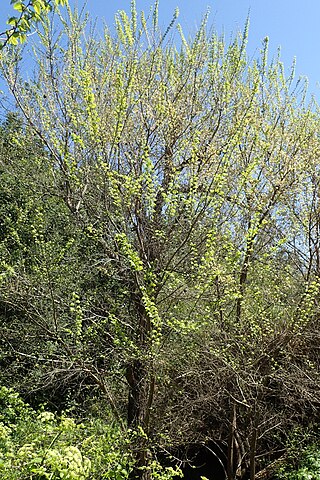
Ulmus minorsubsp.canescens is a small deciduous tree occasionally known by the common names grey elm, grey-leafed elm, and hoary elm. Its natural range extends through the lands of the central and eastern Mediterranean, from southern Italy, the islands of Sicily, Malta, Crete, Rhodes and Cyprus, to Turkey, and as far south as Israel, where it is now considered rare and endangered in the wild. The tree is typically found amidst the comparatively humid coastal woodlands and scrublands.

The putative hybrid cultivar Ulmus × hollandica 'Serpentina' is an elm of unknown provenance and doubtful status. Henry identified it as intermediate between U. glabra and U. minor, a view accepted by Bean and by Melville, who believed that the specimens at Kew bearing the name 'Serpentina' were U. glabra "introgressed by U. carpinifolia" [: U. minor] and were similar to but "distinct from 'Camperdownii'".

The Field Elm cultivar Ulmus minor 'Umbraculifera' [:shade-giving] was originally cultivated in Iran, where it was widely planted as an ornamental and occasionally grew to a great size, being known there as 'Nalband' Persian: نعلبند [:the tree of the farriers]. Litvinov considered it a cultivar of a wild elm with a dense crown that he called U. densa, from the mountains of Turkestan, Ferghana, and Aksu. Non-rounded forms of 'Umbraculifera' are also found in Isfahan Province, Iran. Zielińksi in Flora Iranica considered it an U. minor cultivar.
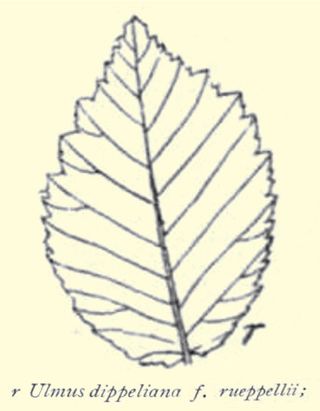
Ulmus minor 'Rueppellii' is a Field Elm cultivar said to have been introduced to Europe from Tashkent by the Späth nursery, Berlin. Noted in 1881 as a 'new elm', it was listed in Späth Catalogue 73, p. 124, 1888–89, and in subsequent catalogues, as Ulmus campestris Rueppelli, and later by Krüssmann as a cultivar.
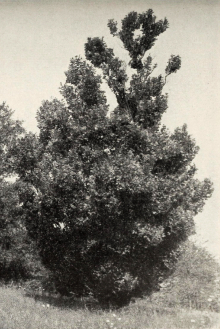
The elm cultivar Ulmus 'Koopmannii' was cloned from a specimen raised from seed sent from Margilan, Turkestan by Koopmann to the Botanischer Garten Berlin c. 1880. Noted in 1881 as a 'new elm', it was later listed by the Späth nursery, catalogue no. 62, p. 6. 101, 1885, as Ulmus Koopmannii, and later by Krüssmann in 1962 as a cultivar of U. minor. Margilan is beyond the main range of Ulmus minor. Augustine Henry, who saw the specimens in Berlin and Kew, believed Koopmann's Elm to be a form of Ulmus pumila, a view not shared by Rehder of the Arbold Arboretum. Ascherson & Graebner said the tree produced 'very numerous root shoots', which suggests it may be a cultivar of U. minor. Until DNA analysis can confirm its origin, the cultivar is now treated as Ulmus 'Koopmannii'.
Ulmus laevis var. celtideaRogow. is a putative variety of European White Elm first described by Rogowicz, who found the tree in 1856 along the river Dnjepr near Chernihiv in what is now northern Ukraine. The type specimen is held at the National Herbarium of Ukraine. The variety was first named as Ulmus pedunculata var. celtidea. Litvinov (1908) considered it a species, calling it Ulmus celtideaLitv., a view not upheld by other authorities.
The Field Elm cultivar Ulmus minor 'Cucullata', the Hooded elm, was listed by Loddiges of Hackney, London, in their catalogue of 1823 as Ulmus campestris cucullata, and later by Loudon in Arboretum et Fruticetum Britannicum (1838), as U. campestris var. cucullata.
The elm cultivar Ulmus 'Globosa' was first described in the Späth nursery catalogue of 1892–93. Considered "probably Ulmus carpinifolia " by Green

The Siberian Elm cultivar Ulmus pumila 'Pendula' is from northern China, where it is known as Lung chao yü shu. It was classified by Frank Meyer in Fengtai in 1908, and introduced to the United States by him from the Peking Botanical Garden as Weeping Chinese Elm. The USDA plant inventory record (1916) noted that it was a "rare variety even in China". It was confirmed as an U. pumila cultivar by Krüssmann (1962).

The Field Elm cultivar Ulmus minor 'Umbraculifera Gracilis' was obtained as a sport of 'Umbraculifera' by the Späth nursery of Berlin c.1897. It was marketed by the Späth nursery in the early 20th century, and by the Hesse Nursery of Weener, Germany, in the 1930s.
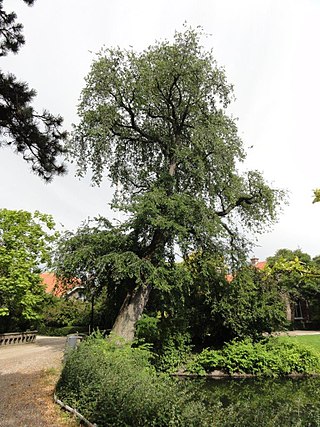
The Field Elm cultivar Ulmus minor 'Pendula' was said to have been raised in Belgium in 1863. It was listed as Ulmus sativa pendula by C. de Vos in 1887, and by Boom in 1959 as a cultivar.

The hybrid cultivar Ulmus 'Androssowii'R. Kam., an elm of Uzbekistan and Tajikistan sometimes referred to in old travel books as 'Turkestan Elm' or as 'karagach' [:black tree, = elm], its local name, is probably an artificial hybrid. According to Lozina-Lozinskaia the tree is unknown in the wild in Uzbekistan, and apparently arose from a crossing of U. densa var. bubyrianaLitv., which it resembles, and the Siberian Elm Ulmus pumila. It is sometimes listed as Ulmus × androssowii.

The Siberian elm cultivar Ulmus pumila 'Pinnato-ramosa' was raised by Georg Dieck, as Ulmus pinnato-ramosa, at the National Arboretum, Zöschen, Germany, from seed collected for him circa 1890 in the Ili valley, Turkestan by the lawyer and amateur naturalist Vladislav E. Niedzwiecki while in exile there. Litvinov (1908) treated it as a variety of Siberian elm, U. pumilavar.arborea but this taxon was ultimately rejected by Green, who sank the tree as a cultivar: "in modern terms, it does not warrant recognition at this rank but is a variant of U. pumila maintained and known only in cultivation, and therefore best treated as a cultivar". Herbarium specimens confirm that trees in cultivation in the 20th century as U. pumilaL. var. arboreaLitv. were no different from 'Pinnato-ramosa'.
The Field Elm cultivar Ulmus minor 'Rugosa' was distributed by the Späth nursery, Berlin, in the 1890s and early 1900s as U. campestris rugosaKirchner. Kirchner's tree, like Späth's a level-branched suberose field elm, was received from Belgium in 1864 as Ulmus rugosa pendula. Kirchner stressed that it was different from Loudon's Ulmus montana var. rugosa, being "more likely to belong to U. campestris or its subspecies, the Cork-elm".
Ulmus boissieriGrudz.,, a disputed species of elm found in Iran, was identified by Grudzinskaya in 1977. She equated her "new species" with the U. campestris f. microphylla collected in 1859 in Kerman Province and described in his Flora Orientalis (1879) by Boissier, for whom she named it, treating Boissier's specimen as the "type". The tree is endemic the provinces of Kermanshah and Kerman., and also the Zagros forests, growing with Quercus brantii, Celtis australis, Platanus orientalis, Fraxinus sp., and Cerasus mahaleb.

The Field Elm cultivar Ulmus minor 'Goodyeri', commonly known as 'Goodyer's Elm', was discovered by John Goodyer in 1624 at Pennington near the Hampshire coast between Lymington and Christchurch. No old specimens are known to survive, but the tree is perpetuated by numerous root suckers, notably in the lanes about the Alice Lisle public house in the New Forest hamlet of Rockford. The tree has suffered misidentification in the centuries since its discovery, firstly by Philip Miller in his 'Gardeners' Dictionary' of 1731, and later in the early 20th century by Augustine Henry and Marcus Woodward, who both confused the tree with Plot Elm, whose centre of distribution is in the East Midlands, some 200 miles away and of completely different appearance.

The Field Elm cultivar Ulmus minor 'Suberosa', commonly known as the Cork-barked elm, is a slow-growing or dwarf form of conspicuously suberose Field Elm. Of disputed status, it is considered a distinct variety by some botanists, among them Henry (1913), Krüssmann (1984), and Bean (1988), and is sometimes cloned and planted as a cultivar. Henry said the tree "appears to be a common variety in the forests of central Europe", Bean noting that it "occurs in dry habitats". By the proposed rule that known or suspected clones of U. minor, once cultivated and named, should be treated as cultivars, the tree would be designated U. minor 'Suberosa'. The Späth nursery of Berlin distributed an U. campestris suberosa alataKirchn. [:'corky-winged'] from the 1890s to the 1930s.
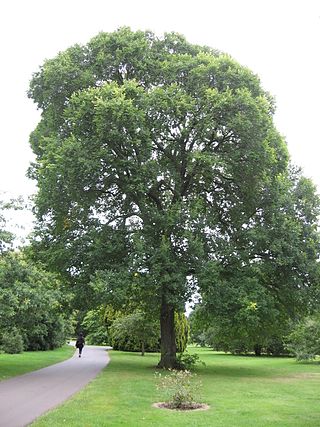
Ulmus 'Karagatch' is a hybrid cultivar from Turkestan, selected in the early 20th century and considered either a backcrossing of U. × androssowii and U. pumila, or simply a cultivar of × androssowii. It was grown from seeds, introduced from Bairam Ali in Russian Turkestan by Arthur P. Davis in the 1930s, as U. 'Karagatch', under which name it was planted at Kew.
The elm cultivar Ulmus 'Turkestanica' was first described by Regel as U. turkestanica in Dieck, Hauptcat. Baumschul. Zöschen (1883) and in Gartenflora (1884). Regel himself stressed that "U. turkestanica was only a preliminary name given by me; I regard this as a form of U. suberosa" [:U. minor ]. Litvinov considered U. turkestanicaRegel a variety of his U. densa, adding that its fruits were "like those of U. foliaceaGilibert" [:U. minor].


















